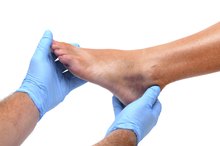Is Swimming OK for Foot Tendinitis?
Inflammation of the tendons in your foot results in foot tendinitis. Foot tendinitis treatment can involve a period of rest to eliminate the stress placed on the tendons of your foot, steroid injections, splinting and exercises to improve the muscle balance and flexibility of your foot. Swimming can allow you to stay in shape while allowing the tendons in your foot to rest.
Types
Tendinitis refers to any acute injury to a tendon. The location of the pain, swelling and inflammation help determine the type of foot tendinitis. Common locations include along the top, outside, arch and behind the heel of the foot and along the inside of the ankle. Each location has different name, including anterior tibial, peroneal, posterior tibial, Achilles, extensor and flexor tendonitis. The most common form of foot tendinitis is Achilles tendinitis, according to Dr. Lara Allman, a podiatrist for Advanced Foot and Ankle Services at DuBois Regional Medical Center in DuBois, Pennsylvania 1.
- Tendinitis refers to any acute injury to a tendon.
- The most common form of foot tendinitis is Achilles tendinitis, according to Dr. Lara Allman, a podiatrist for Advanced Foot and Ankle Services at DuBois Regional Medical Center in DuBois, Pennsylvania 1.
Causes
Pronation Foot Exercises
Learn More
Tendinitis occurs when a tendon is placed under too much stress, which can result from a sudden increase in physical activity, excessive standing, walking without shoes for extended periods of time or twisting the foot or ankle. As you enter middle age, suffer from certain types of arthritis, have flat feet or have extra bone under your tendon, the stresses placed on your feet during everyday activities can also lead to tendinitis. You may experience a deterioration of the tendons in your foot, which increases the stress placed on your tendons, Allman says.
Swimming With Tendinitis
The first step in treating foot tendinitis involves reducing the stress by reducing or eliminating weight-bearing activity. Swimming provides you with an opportunity to maintain your fitness level or exercise routine even when you do not have permission to walk. The cool water of an unheated pool may help reduce inflammation, and the warm water of a heated pool can improve blood flow, increasing the effectiveness of foot stretches designed to add flexibility to foot muscles and decrease the stress on your tendons. Stretch the foot, ankle and leg muscles before and after each swimming workout to decrease your risk of worsening your tendinitis. Allman notes that severe forms may make swimming difficult because of reduced mobility of your foot, even in water.
- The first step in treating foot tendinitis involves reducing the stress by reducing or eliminating weight-bearing activity.
- Allman notes that severe forms may make swimming difficult because of reduced mobility of your foot, even in water.
Prevention
Ankle Pain & Swimming
Learn More
Prevention of tendinitis reduces the amount of time you have to spend performing swimming workouts instead of the workout of your choice. Avoid pushing yourself too hard by slowly increasing your endurance or stamina while on your feet exercising. Gentle stretching of the muscles of your feet, ankle and lower legs increases the flexibility of the muscles connected to your tendons and decreases stress on the tendons. Wear shoes or inserts that support your foot properly throughout your activities to further decrease stress.
- Prevention of tendinitis reduces the amount of time you have to spend performing swimming workouts instead of the workout of your choice.
- Wear shoes or inserts that support your foot properly throughout your activities to further decrease stress.
Related Articles
References
- Dr. Lara Allman; Advanced Foot and Ankle Services at DuBois Regional Medical Center; DuBois, Pennsylvania
- American Academy of Orthopaedic Surgeons; Achilles Tendinitis; June 2010
- Meridian Family Foot & Ankle Clinic: Tendon Disorders
- Bito T, Tashiro Y, Suzuki Y, et al. Forefoot transverse arch height asymmetry is associated with foot injuries in athletes participating in college track events. J Phys Ther Sci. 2018;30(8):978–983. doi:10.1589/jpts.30.978
- Freedman BR, Gordon JA, Soslowsky LJ. The Achilles tendon: fundamental properties and mechanisms governing healing. Muscles Ligaments Tendons J. 2014;4(2):245–255. Published 2014 Jul 14. PMID: 25332943
- Tips to Keep Feet Warm and Cozy All Winter Long. Winter Foot Care. American Podiatric Association
- Park SY, Bang HS, Park DJ. Potential for foot dysfunction and plantar fasciitis according to the shape of the foot arch in young adults. J Exerc Rehabil. 2018;14(3):497–502. Published 2018 Jun 30. doi:10.12965/jer.1836172.086
- Petraglia F, Ramazzina I, Costantino C. Plantar fasciitis in athletes: diagnostic and treatment strategies. A systematic review. Muscles Ligaments Tendons J. 2017;7(1):107–118. Published 2017 May 10. doi:10.11138/mltj/2017.7.1.107
- Pita-Fernandez S, Gonzalez-Martin C, Alonso-Tajes F, et al. Flat Foot in a Random Population and its Impact on Quality of Life and Functionality. J Clin Diagn Res. 2017;11(4):LC22–LC27. doi:10.7860/JCDR/2017/24362.9697
- American Academy of Orthopaedic Surgeons. Posterior Tibial Tendon Dysfunction. Sept 2017.
- Arthritis Foundation. Anatomy of the Foot.
- Mayo Clinic. Hammertoe and Mallet Toe. July 28, 2917.
Writer Bio
Kimberly Wonderly has a Bachelor of Science degree in exercise science and has worked as a personal trainer for six years. Wonderly has also taken many child development classes, while running a daycare out of her home for three years. She wrote for the "Rocket" at Slippery Rock University for two years while attending college.









